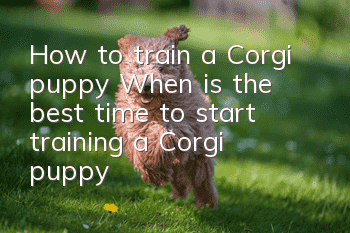How to train a Corgi puppy? When is the best time to start training a Corgi puppy?

The best period for corgi training
① Start training at 3-4 months old. This is the period when all dogs have the best understanding of the world and their ability to learn. For your better dog-raising life in the next ten years or more, it is recommended to choose a professional dog training training school to study systematically. Professional institutions can better provide different professional training subjects and schedules based on the owner's family environment, work and rest time, different breeds of dogs, and dogs of different ages.
Corgi training key points
① Socialization training: As a family companion dog, the dog must learn How to get along correctly with people and dogs. Avoid timidity, aggression, and chasing other dogs, vehicles, etc. due to lack of correct social skills.
② Self-control training: Let the dog learn self-discipline. No more trouble caused by being unable to control the ancient power within the body. Improve the dog's obedience and make the Corgi more obedient.
③ Alone ability training: Let the dog learn how to spend alone time correctly, and no longer tear up the house or disturb the people by barking because of the lack of exercise.
④ Key subject selection: Corgi attacks, chases cars, barks to disturb people, tear apart homes, etc. are all caused by their high energy and the nature of herding dogs. Therefore, in view of the characteristics of Corgi dogs, it is recommended not to use violent methods in training. Key subjects of family companion dog training: early childhood socialization, waiting, prohibition, cage entry, traction and other obedience subjects.
Corgi key training subject methods:
① Dog socialization: in 4 dog Before it is one month old, let it play with humans or dogs with friendly and docile personalities as early as possible.
② Dog self-control: Let the dog learn the wait and prohibition commands from an early age. Understand what can and cannot be done and when to do it.
③ Dog’s ability to be alone: Prepare a space for the dog to be alone (cage or flight box), suitable molars and toys for solitude. Let them stay in their own space while you're out and give them the toys or molar bones you've prepared. Help them kill the boring time alone and the energy they have nowhere to vent.
The specific steps of "retrieval" training (examples)
① Prepare some Food that dogs like to eat (it is recommended to choose dog food or small pet snacks)
② Quiet and comfortable environment. (For example, an empty room, roomThere should not be too many objects or other dogs or people in the room, otherwise the dog’s attention will not be on you! )
③ Your patience. Because training is a slow process.
④ Take advantage of the dog’s natural tendency to learn to play and chase, and throw the toys out.
⑤ When the dog holds the toy in its mouth, exchange the food in your hand for the toy in its mouth.
⑥ After multiple trainings, the dog can learn to "retrieve".
- What do dogs eat to protect their stomach? It is important to protect their stomach and treat gastrointestinal diseases in dogs.
- How to tell if your dog is fat? Is your dog overweight?
- Will your dog catch a cold if you blow the air conditioner? What should you do if your dog catches a cold if you blow the air conditioner?
- What should you pay attention to when your dog drinks water? Don’t be careless when it comes to your dog’s drinking water.
- The dog's mouth bites and shakes. Why does the dog's mouth occasionally shake and bite?
- How to cut a dog's hair? Do you know how to cut a dog's hair correctly?
- Can dogs eat raw eggs? Why can’t dogs eat egg whites?
- Common Dog Problems in Summer How to Deal with Different Dog Problems
- How to keep dogs away from skin diseases. If you do this, will you see if your dog will still be infected with skin diseases?
- What causes anorexia in dogs? Dogs will become anorexic due to lack of exercise. Hounds run at least 5KM every day.



